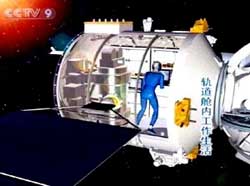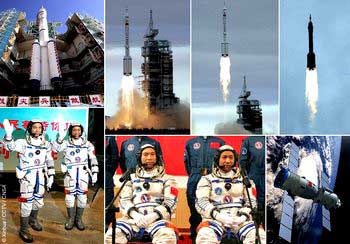China Announces Manned Space Mission – Shenzhou-7 to Conduct Spacewalk in 2008
Recently, the China Manned Space Flight Engineering Office (CMFSE) announced plans to launch the Shenzhou-7 spacecraft in 2008 with a mission to perform a spacewalk.
After a long silence following the successful Shenzhou-6 mission, Wang Zhougui, the director of CMFSE, stated that the development of China’s space program will proceed in three phases in the near future.
The first phase is currently underway, with Shenzhou-7 set to carry its astronauts into space for a spacewalk mission in 2008.
 |
“The astronauts of Shenzhou-7 will exit the spacecraft and ‘breathe’ the vastness of space…” (Source: CCTV) |
Preparing to Establish a Space Dock
According to a recent report, Shenzhou can carry three astronauts into space.
The second phase will involve the launch of Shenzhou-8 to carry out important missions for “a final docking station” in the vastness of space. The third phase will see China establishing its own space station, the third after those of the United States and the former Soviet Union.
According to Wang, the astronauts of Shenzhou-7 will exit the spacecraft and “breathe” the vastness of space.
“The astronauts will walk in space wearing a self-designed spacesuit and conduct several experiments. Our initial plan is to have one or two astronauts walk in space for about 30 minutes,” Wang Zhougui stated.
Next, Shenzhou-8, tasked with the role of a space dock, is expected to be launched between 2009 and 2010.
Initiating a New Generation of Shenzhou Missions
Shenzhou-7 is slated for a flight duration of approximately four to five days, providing ample time to complete the spacewalk mission.
A spacewalk is a logical next step after China successfully launched manned missions into orbit, particularly with Shenzhou-6 in 2005.
 |
| Images from the Shenzhou-6 mission in November 2005. (Source: expeditionzone) |
China became the third country to independently send its citizens into space, following the Soviet Union (1961) and the United States (1962).
The manned spacecraft, Shenzhou, is based on Russia’s Soyuz spacecraft but has been modernized and adapted to meet the needs of Chinese astronauts and scientists.
The success of Shenzhou-6 further solidified China’s position in the field of space exploration. Generations of spacecraft from Shenzhou-7 to Shenzhou-10 are currently being developed by China.
The two-seat Shenzhou-6 spacecraft was launched into space in November 2005, two years after the country successfully sent its first astronaut into orbit in 2003.
The Shenzhou-6 crew traveled 2 million miles (3.2 million kilometers) in space, with a total mission duration of 115 hours and 32 minutes, which is 21.5 times longer than China’s first one-person flight in 2003.
Hương Cát (Compiled)




















































